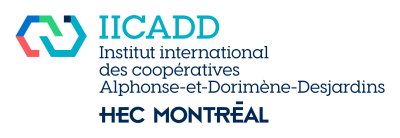Welcome to the GICS
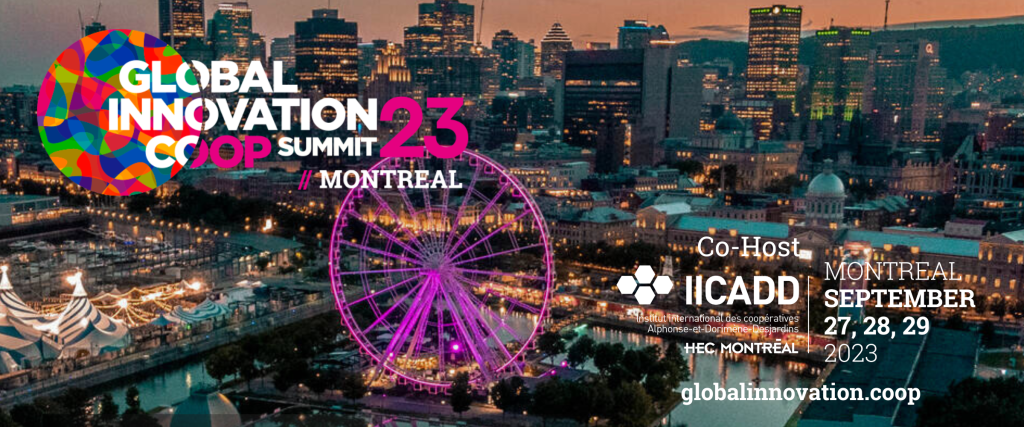
The Institut international des coopératives Alphonse-et-Dorimène-Desjardins (IICADD) will host the Global Innovation Coop Summit (GICS), from September 27-29 in Montreal (Canada). The theme of this GICS edition is “Act Now to Lead a Circular and Digital Cooperative Future the Cooperators Way”. The summit will focus on cooperatives in relation to circular economy, digital transformation and the principle of intercooperation. There will be speakers from both academia as well as from cooperatives and other organizations. Lectures will be combined with interactive workshops to generate ideas about what cooperatives and their partners can and should be doing to advance just and sustainable transitions. The conference will take place in the new HEC Montréal building in downtown Montreal.
We hope to see you in Montreal this fall!
- Under 35 years old? You may be eligible for funding from Coop Canada! Find out more here.
- Vous êtes Français.e ? L’OFQJ pourrait vous aider à participer
About the Institut international des coopératives Alphonse-et-Dorimène Desjardins of HEC Montréal
Founded in 1975, the Institut international des coopératives Alphonse-et-Dorimène-Desjardins is a research unit of HEC Montréal that supports the cooperative movement with digital data. The Institute aims to understand and promote the place and role of cooperatives in the economy and society. It thus aims to inform management practices, policies, and future actions to promote the identity of cooperatives and ensure their development.
Chaired by Mr. Guy Cormier, President and Chief Executive Officer of Desjardins Group, the Institute is structured in four fields of activities that have an overall logic and reinforce each other:

- PortailCoop : Promote the access, development and sharing of knowledge on cooperatives and mutuals in the digital age.
- Students : Equip students and professors on cooperatives and mutuals.
- Research : Inspire, lead and support research on the cooperative and mutualist movement.
- Transfer : Develop, adapt, and disseminate knowledge on the management of cooperatives and mutuals.
PortailCoop, the world’s largest digital library on cooperatives and mutuals, is a unique tool for organizing and disseminating digital materials and data on cooperatives and mutuals in an academic library to support research in the field. PortailCoop includes over 64,000 references in 19 languages and a circular economy and cooperatives collection was launched in 2022.
Created in 2022, the Students field of activity aims to equip the HEC Montréal community on cooperatives and mutuals. By informing, inspiring, and supporting students, they will be better able to seize opportunities to include cooperatives in their learning process and to carry out their work in the field.
Through its Research field of activity, the Institute wishes to promote PortailCoop to researchers, support research on cooperatives and mutuals at HEC Montréal and develop unique skills in cooperative research. The Institute’s research is carried out under three themes that allow for numerous collaborations with other universities and cooperatives (action research):
- Cooperatives and circular economy
- Cooperatives and Latin America
- Action research cooperatives
The Institute is creating a new international network on social economy and circular economy with funding from the Social Sciences and Humanities Research Council of Canada.
The Transfer field of activity includes innovative projects in collaboration with the cooperative and mutualist community such as the publication of studies, training activities, and simulations. These projects focus on the management of cooperatives with a practical and innovation-oriented approach. In 2022, the Institute developed the massive open online course (MOOC) “Gestion des coopératives et des mutuelles : au cœur d’un mouvement” with three other Quebec universities and the Conseil québécois de la coopération et de la mutualité.
Committees
The realization of the GICS in Montreal is possible thanks to the work and commitment of the members from various working committees. We thank them warmly!
Organizing committee
The GICS organizing committee sets the direction for the Montreal event and ensures that each step of the organization runs smoothly.
Committee members
Scientific committee
The GICS scientific committee is supporting the development of the program content at the Montreal event for its three themes: circular economy, digital transformation and intercooperation.
- Luc Audebrand, Full professor, Laval University, Canada
- Justine Ballon, Assistant professor, Department of Management, HEC Montréal, Canada
- Karen Miner, Executive director, International Centre for Co-operative Management, Université Saint Mary’s, Canada
- Sonja Novkovic, Professor, Academic director, International Centre for Co-operative Management, Saint Mary’s University, Canada
- Rafael Ziegler, Associate professor, Department of Management, HEC Montréal, Canada
Advisory committee
Description
Committee members
Logistics committee
This committee is responsible for all the logistical aspects of the GICS: reception and layout, rooms, technical and computer services, catering services, volunteers, etc. It also ensures that the various audiovisual and material needs of the activity organizers are met.
- Marc Belleau, Administrative assistant, Institut international des coopératives Alphonse-et-Dorimène-Desjardins of HEC Montréal
- Eléonore Compère, Project manager, Institut international des coopératives Alphonse-et-Dorimène-Desjardins of HEC Montréal
- Marie-Josée Lapointe, Administrative director, Institut international des coopératives Alphonse-et-Dorimène-Desjardins of HEC Montréal
HEC Montréal. Where opportunities are created
HEC Montréal is a French-language university institution offering internationally renowned management education and research. The university has been training future managers who contribute to our society’s growth and prosperity, since 1907.
HEC Montréal in brief
- 13 417 students, of which 3 676 are international students from 145 countries,
- Over 110 000 alumni since its establishment,
- More than 100 programs in management from 1st to 3rd cycle,
- 312 faculty members with expertise in all areas of management,
- 699 administrative and support staff,
- 36 research chairs and 30 groups of research and hub of transfer,
- 4 published journals,
- More than 9 000 people trained per year at Executive Education HEC Montréal,
- The largest international management exchange program in Canada: 198 partner institutions in 56 countries and regions,
- 3 linguistic paths at the bachelor’s degree level: French; bilingual (French and English); trilingual (French, English, and Spanish).
You will find the history of HEC Montreal at the following link.
Hélène-Desmarais building
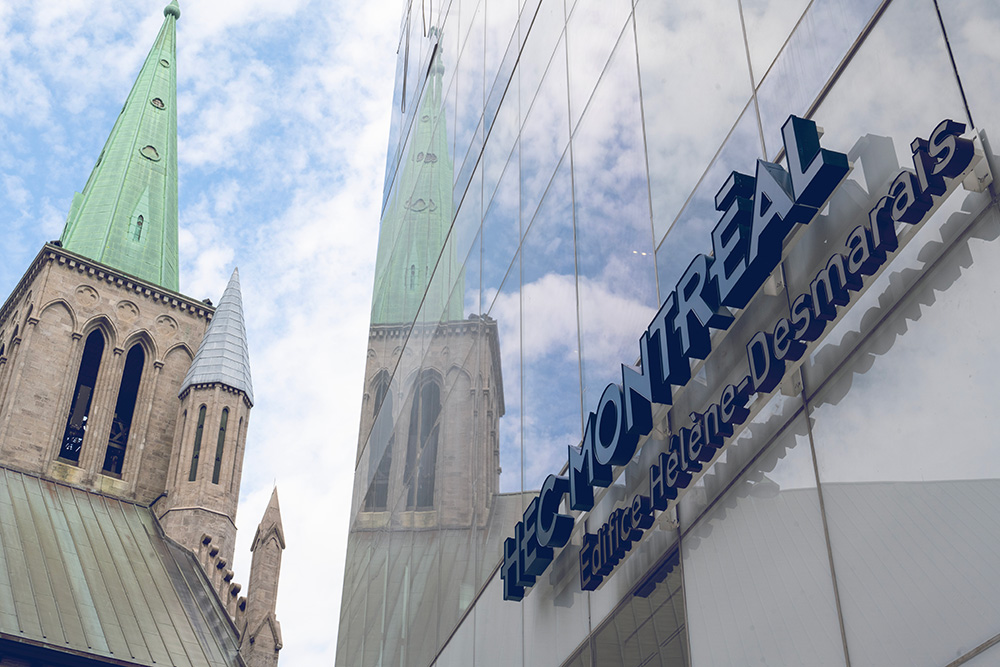
The event will take place at the HEC Montréal Hélène-Desmarais building (501, de La Gauchetière West Street, Montréal).
HEC Montréal was the first business school to open its doors in Canada, in 1907. Since then, it has a reputation for avant-garde and leadership in teaching and research and is well established in Quebec, Canada, and the world. Its facilities, which are functional, bold, and convivial reflect this status and the high standards the School has set for itself, and make it an exceptional place of learning, open to all.
The HEC Montréal Hélène-Desmarais building is a new building which opened its doors in 2023. The building is located in the creative, vibrant, and cosmopolitan downtown Montréal, in the province of Quebec, Canada. Montréal is known for its cultural diversity, architecture, and rich history.
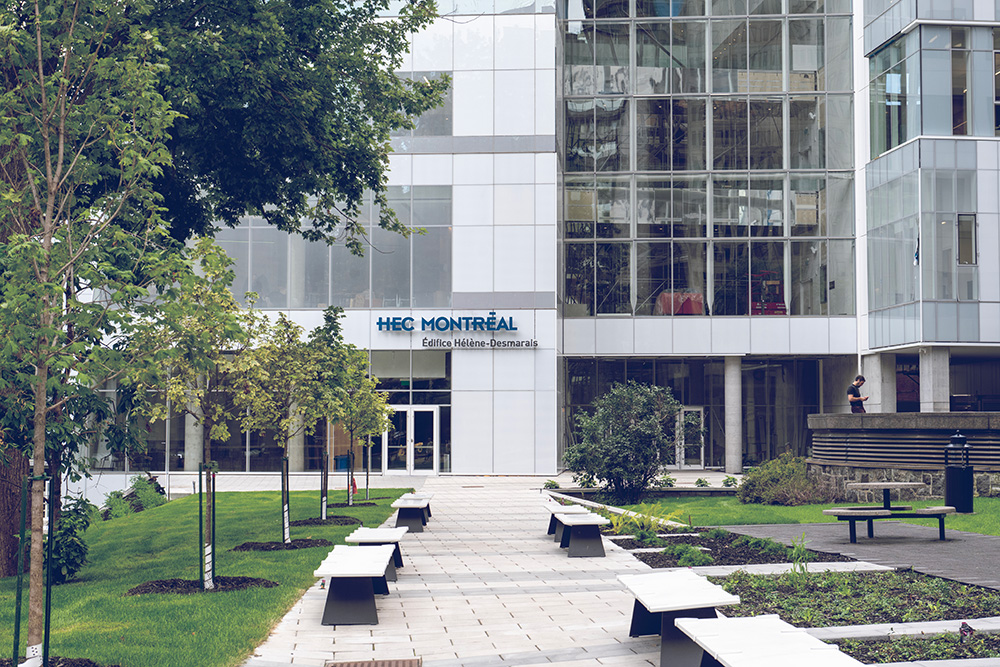
The Hélène-Desmarais building presents a modern and innovative design thought to provide natural light in almost all interior spaces. It was designed by Provencher Roy according to three main themes; dynamism, a contemporary style in the choices of implantation, volumetry and materials used, lightness, a building that fits into the urban fabric by contrasting the lightness of the new building with the mass of the older buildings, and respect of the place, considering heritage protection areas and the establishment of a dialogue with its surroundings through the treatment of the facades and the angulations that provide views from de La Gauchetière Street and Beaver Hall Hill.

The building is seeking LEED Gold certification, meaning sustainability was a priority while designing it. For example, the building includes green roofs, geothermal wells, landscaping for biodiversity, tree transplants, and measures to encourage mobility. These are just a few of the concrete ways implemented to ensure a responsible and sustainable construction of this new building.

The Hélène-Desmarais building consists of several academic departments and research centers and is equipped with the latest technology for videoconferencing, multimedia classrooms, and more. It also provides several collaborative spaces for students and faculty members to work and socialize.
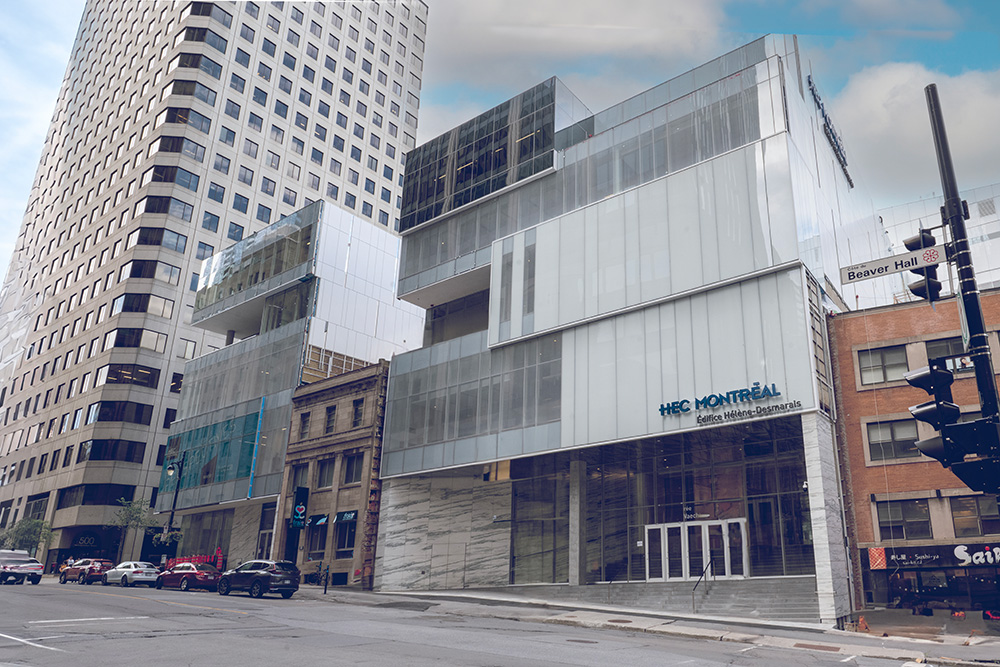
HEC Montréal Campus – Brochure (French only)
Cultural heritage sites nearby
Located in the Ville-Marie borough, the Hélène-Desmarais building has an excellent location. Many places of interest are nearby, including:
- Important cultural heritage sites (see subsections Saint Patrick’s Basilica, Coteau Saint-Louis or Coteau Saint-Antoine, Refuge St. Bridget, and Terrasse des imprimeurs);
- Major multinational offices, including Google, Red Bull, and the Canadian Olympic Committee;
- The building is in the heart of Montreal’s business district, surrounded by many stores, hotels, restaurants, and museums;
- For walking and bike-sharing BIXI enthusiasts, the Old Port of Montreal is a few minutes away;
- Chinatown can be found a few blocks away, part of which has been classified as a heritage site since January 21, 2022, under the name “Site patrimonial du Noyau-Institutionnel-du-Quartier-Chinois”.
Saint Patrick’s Basilica
The Basilica is a direct witness to the history of Montreal’s Irish community. A traditional Catholic place of worship, its construction was completed in 1847 to accommodate parishioners from various waves of immigration. The first mass was celebrated on Saint Patrick’s Day, March 17, 1847.
Saint Patrick’s Basilica was classified as a historic monument by the Ministry of Culture and Communications in 1985, elevated to the rank of a minor basilica by Pope John Paul II in 1989, and designated a “national historic site” by the federal government in 1996.
Coteau Saint-Louis or coteau Saint-Antoine
The area where the Hélène-Desmarais building now stands was called “Coteau Saint-Louis” according to the Dictionary of Biography and “Coteau Saint-Antoine” according to the City of Montreal’s statement. The area was originally a part of lots belonging to Joseph Frobisher, an entrepreneur, fur trader and deputy who contributed greatly to Montreal’s commercial, urban, and political development.
Esplanade of the Rocheblave house
Part of the Hélène-Desmarais building and its esplanade cover the site once occupied by a house built on the Beaver Hall hillside shortly before the year 1800 by the same Joseph Frobisher, who also lived there.
In 1819, this two-storey stone house became the residence of Pierre de Rastel de Rocheblave, also a fur trader, businessman and deputy, who was a militia officer and justice of the peace. Three years after the death in 1840 of this important figure in the development of Montreal as a commercial metropolis, his estate sold the house and a plot of land to the Fabrique de la paroisse Notre-Dame, of which he had been churchwarden and treasurer of the construction committee.
The history of the Rocheblave house is intimately linked to the institutional works set up by Catholic communities to help the most disadvantaged, particularly those from Irish immigration in the 19th century. Its uses evolved over time, but the old building played a key role for the community it served:
- from 1847 to 1848, the Grey Nuns set up the Saint Patrick’s building, a charity for Irish orphans;
- from 1848 to 1860, the priests of the Saint Patrick mission used it as a presbytery;
- and from 1860 to 1869, the Rocheblave house hosted the work of Father Patrick Dowd’s Refuge St. Bridget until a new building was opened further south. The old house then reverted to an orphanage.
The Rocheblave house was enlarged to the west in 1865 to better accommodate its clientele. It was finally demolished between 1903 and 1907.
In tribute to this memory, HEC Montréal decided to name the esplanade in front of the entrance of René-Lévesque Boulevard West, “Esplanade de la Maison de Rocheblave” (Esplanade of the Rocheblave House).
Saint Bridget Shelter
The southern part of the building occupies a site that for over a century was home to Saint Bridget’s Shelter, a place intended to accommodate the elderly and disabled. It was also used as a shelter for women who were victims of violence and as a soup kitchen for the homeless.
The building, designed by architect Victor Bourgeau, opened in 1869 at the request of Father Patrick Dowd, mentioned above.
The Grey Nuns administered the Refuge until 1944, when it was taken over by the Sisters of Providence of Kingston. In 1977, the Refuge was moved to a new facility for the elderly in the Côte-des-Neiges neighbourhood.
The building was then demolished, and the site turned into a parking lot. In 1998, with the help of patrons, Saint Patrick’s Basilica uncovered the stone foundations of the former refuge and converted the site into a recreation area.
Before the start of the construction of our current building in 2019, only these few visible vestiges served as a reminder of the building’s existence and the social work to which it was dedicated.
Sensitive to the memory of this place, HEC Montréal decided to permanently highlight the place occupied by the Refuge Saint Bridget by tracing the original location of the foundations of this former refuge on the interior and exterior floors of the Hélène-Desmarais building. One of the two outside walls has even been partially rebuilt with stones from the site. It is located in front of de La Gauchetière West Street entrance. The other is on the basilica side, near the Espace BMO.
Terrasse des imprimeurs
Adjacent to the food court, the Terrasse des Imprimeurs (the Printers’ Terrace) is named to commemorate the history of this quadrangle, which in the early 20th century housed numerous buildings linked to the printing industry.
The printing district – or Paper Hill as it was known – was bounded by Saint-Antoine Street, René-Lévesque West Boulevard (Dorchester at the time), Beaver Hall Hill and de Bleury Street. This area, with its pronounced topography, adjoined the Old Montreal where the city’s major newspapers were located (Montreal Star, The Gazette, La Presse).
Several industrial heritage buildings, evidence of the printing district, remain in the quadrangle that today houses the Hélène-Desmarais building. Most have been converted into residential buildings. From the Terrasse des Imprimeurs, adjacent to Espace BMO on de La Gauchetière West Street, you can see the Gillette, Wilson, and Southam buildings on Saint-Alexandre Street. Nearby, on de La Gauchetière West Street, are the Read and Unity buildings.
One of them, the Unity building facing Saint Patrick’s Basilica, has been classified as an historic monument by the Quebec government and designated as a building of exceptional heritage value by the City of Montreal. It was one of the first buildings in Montreal to use a concrete slab and column construction system called mushroom slab construction. Its architecture bears a certain influence of the Chicago School, the precursor of 20th-century skyscrapers.
For more information, we invite you to listen to the podcast on the building’s heritage, neighbourhood-friendly design, and artworks (in French only).
Getting to the GICS
The event will take place at HEC Montréal’s Hélène-Desmarais Building, 501 de La Gauchetière West Street, Montreal, Quebec, Canada.
There are three entrances to access the building: de la Gauchetière West Street, Beaver Hall Hill and René-Lévesque Boulevard.
You can use this Google Maps link to plan your way to the venue.
Orientation terminals
To facilitate circulation within the building, four orientation terminals, located near the four main entrances, are available for staff, students, and visitors.
These interactive terminals operate using a QR code and enable anyone needing directions to find their way to their destination within the building (classrooms, meeting rooms, administrative areas, and conference rooms).
Public transportation (STM subway and bus)

HEC Montréal’s Hélène-Desmarais building is served by the Square-Victoria-OACI metro station (orange line). Exit via Viger West Avenue or Beaver Hall Hill.
You can use the Société de transport de Montréal (STM) website to plan your journey down to the minute. You can also use the TRANSIT app to find nearby transportation options.
Various rates are available, depending on the length of your stay. To find out more, click here.
Active transport
Bike racks are available at HEC Montréal’s Hélène-Desmarais building.
For information about getting around by bike with BIXI self-service bicycles, click here.
Carpooling
Several car-sharing companies provide connections between different cities in Quebec and Canada.
- Amigo Express : www.amigoexpress.com
- Covoiturage.ca : www.covoiturage.ca
- Poparide : www.poparide.com/fr/
Parking
Indoor parking at HEC Montréal’s Hélène-Desmarais building
501, rue de La Gauchetière Ouest
Indoor parking Palais des congrès de Montréal
1025, rue Chenneville, accessible via l’avenue Viger
Indoor parking Quartier international de Montréal
Parking Indigo Montréal M175
500, boulevard René-Lévesque Ouest
Taxis
Cabs are readily available at Montréal-Pierre Elliott Trudeau International Airport. Look for designated cab stands outside the terminal. Fares are calculated by the meter, and it’s customary to tip the driver.
- Taxi Coop : 514 725-9885
- Champlain : 514 271-1111
- Taxi Diamond : 514 836-0000
- Taxi Bonjour : 514 366-3333
Plane
From the airport, you can take one of the following means of transportation to get to downtown Montreal:
- Taxis – about $50 per trip or limousine service.
- Bus « ligne 747» (24 h/24, 7j/7) – between Montréal-Trudeau airport and the Gare d’autocars de Montréal (Berri-UQAM metro station). The fare is $11.
- You can buy your ticket inside the airport or pay in exact change on the bus. This fare provides a pass valid for 24 consecutive hours on the entire STM bus and metro network. Travel time is 45 to 60 minutes, depending on traffic.
Train
Montreal Central Station is located at 895, de La Gauchetière West Street (under the Queen Elizabeth Hotel, near Bonaventure and McGill metro stations). You can book a train ticket with the ViaRail and Amtrack companies (they connect Montreal to all cities in Canada and the US).
Bus
The Gare d’autocars de Montréal (Montreal Bus Station) is located at 1717 Berri Street. Several bus companies offer daily service.
Registration
To register and pick up your name tag, go to the registration desk in room C.371 Reception room for groups and activities – Student association donation.
Registration counter hours:
- Wednesday, September 27: 2pm to 6pm
- Thursday, September 28: 7am to 5pm
- Friday, September 29: 7am to 1pm
Please note! To ensure efficient service at the registration desk, you will not be allowed to pick up another person’s equipment.
Checkroom
A checkroom is available close to the Centre de conférences on level 3.
Tourism
Montreal is a dynamic city with a rich cultural heritage and many attractions. Don’t miss these popular sights:
- Old Montreal: explore the historic district with its charming cobblestone streets, stunning architecture and renowned landmarks such as Notre-Dame Basilica.
- Mount Royal: visit magnificent Mount Royal Park, with its panoramic views of the city. Enjoy the hiking trails, picnic or simply relax in nature.
- Montreal Museum of Fine Arts: immerse yourself in art and culture at this world-class museum featuring a varied collection of masterpieces from different eras and styles
To discover Montreal:
Accommodation
Book your accommodation in advance! Take advantage of your stay to discover Montreal’s many attractions.
We invite you to consult the list of hotels near the GICS and to use active or public transportation for your trips. If you have any questions, please contact the establishments using the contact details provided.
COOP HEC Montréal
During the entire GICS, a food offer consisting of coffee breaks in the morning and afternoon, and a lunch, will be available to participants. The Coop HEC Montréal is the official food service provider for the Montreal event.
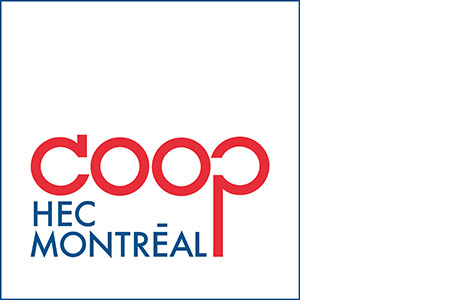 In operation for nearly 80 years, Coop HEC Montréal is one of the two oldest school cooperatives still in operation in Quebec, along with Coopoly at École Polytechnique de Montréal. It offers food services, printing services, boutiques, and parking to the community of HEC Montréal’s three buildings.
In operation for nearly 80 years, Coop HEC Montréal is one of the two oldest school cooperatives still in operation in Quebec, along with Coopoly at École Polytechnique de Montréal. It offers food services, printing services, boutiques, and parking to the community of HEC Montréal’s three buildings.
At the Hélène-Desmarais building, a bistro service offered by the Coop HEC Montréal is available on level 1 and is accessible from de La Gauchetière West Street. If you want to sit down and eat on site, you can take advantage of the Espace BMO.
Coop HEC Montréal also has a boutique in the Hélène-Desmarais building. It is located on level 1 of wing B. It offers its members and the public a bookstore, school and computer supplies, as well as HEC Montréal souvenirs and merchandise.
About Coop HEC Montréal
The HEC Student Cooperative Association was founded on October 6, 1944, on the initiative of fifteen students from the École des hautes études commerciales de Montréal. From the outset, the school’s management embraced the idea of a cooperative within its walls.
It must be said that the HEC Montréal environment is particularly fertile for the establishment of such an organization. Indeed, Esdras Minville, director of the institution at the time and an economist advocating a certain Quebec economic nationalism, was particularly sensitive to this form of organization. In his eyes, collective ownership and democratic control ensured development at the service of the community. What’s more, certain members of the faculty, including Victor Barbeau and François Albert Angers, promoted the cooperative form of organization. Initially focusing on the sale of educational and business books and stationery, the cooperative later expanded its range of services. In the ‘70s, it opened a food counter on Decelles Street, with sales reaching $1.3 million in 1979. In the ‘80s, a small computer store was opened at the same address, and by 1989 sales had reached $5.4 million.
But it was in 1996 that things changed significantly for the cooperative with the construction of the new building on Chemin de la Côte-Sainte-Catherine. It was then entrusted with all commercial services for the institution’s two buildings, making it one of the pillars of the HEC Montréal community. In 2015, the cooperative’s sales reached $11 million, and the company hired over 125 employees.
Since 1996, the cooperative has adapted to HEC Montréal’s significant growth. Among other things, Coop HEC Montréal has reformed its Board of Directors and governing bodies to ensure more effective governance, invested over $4 million to provide commercial services essential to the smooth running of the university, and put in place the organizational structure needed to deliver top-quality services.
The cooperative’s mission
Coop HEC Montréal’s mission is to contribute to the economic and social well-being of members of the HEC Montréal community, in keeping with cooperative values and principles. Also, as a privileged partner of HEC Montréal, Coop HEC Montréal is committed to meeting the needs of community members in the service offering associated with the institution’s mission.
Coop HEC Montréal must be:
- Dedicated to its members.
- A key development partner for HEC Montréal.
- An employer of choice for its employees.
Strategic objectives:
- Focus on an exceptional customer experience.
- Take advantage of business opportunities.
- Leverage the HEC Montréal brand.
- Be a leading player in sustainable development.
For more information on the history of school cooperatives in Quebec, click here.
Notice to travelers
The GICS 2023, to be held from September 27 to 29, 2023, will take place on-site at the Hélène-Desmarais building of HEC Montréal, Quebec, Canada. When planning travel to the event, participants should ensure that they comply with the health regulations of their country of origin and of Canada for international travel in connection with the COVID-19 pandemic.
To visit Canada and participate at the GICS, you may need an Electronic Travel Authorization (eTA) or a visa. Please note that it is your responsibility to make the necessary arrangements with the appropriate administrative authorities. GICS cannot intervene in any way. We urge you to contact the relevant institutions as soon as possible, as it can sometimes take several months to obtain the documents you need for your trip.
Electronic Travel Authorization (eTA)
The Electronic Travel Authorization (eTA) is an entry requirement for foreign nationals from visa-exempt countries flying to or transiting through Canada. The AVE is an electronic document linked to your passport and remains valid for five years, or until your passport expires, whichever comes first (source: Government of Canada).
For full details, visit the Government of Canada website.
Visa application
A visa is an official document stamped in your passport. It indicates that you meet the necessary conditions to travel to Canada (source: Government of Canada). We advise you to apply for a visa as soon as possible, as delays are to be expected. The Canada Border Services Agency is currently experiencing delays in issuing visas. For those who require a visa, we recommend that you apply quickly. Consult the official Canadian government website or contact your nearest Canadian embassy or consulate for the latest information on visas and entry permits.
GICS can provide you with a letter of invitation on request. Please forward your request toChristina Procopio.
For full details, visit the Government of Canada website.
COVID-19
The Canadian government no longer requires valid proof of vaccination to board a train or plane (domestic or international).
However, GICS participants are invited to follow the updates published on our site for the latest news on the health measures in place for the Montreal event. We also invite you to consult the Government of Quebec’s website for information on measures in effect, and the Government of Canada’s website for information on Travel, Screening and Borders.
ArriveCAN
It is no longer mandatory to use ArriveCAN, to transmit travel information before and after entering Canada (source : Canadian government).
COVID-19
The GICS organizing teams follow closely Public Health guidelines. Measures are being taken to offer the best possible experience to participants in a safe environment. The information on this page will be updated according to the directives of the Canadian and Quebec governments until the event takes place.
GICS participants are invited to follow the updates posted on our website for the latest news on the health measures in place for the Montreal event. We also invite you to consult the Government of Quebec’s website for information on measures in effect, and the Government of Canada’s website for information on Travel, Screening and Borders.
Self-assess your health before coming to GICS
It’s important to do a self-assessment of your health before coming to the event. Use the COVID-19 symptom self-assessment questionnaire.
Do not attend the event if:
- You have had a positive rapid or PCR test result for COVID-19,
- You have symptoms similar to COVID-19.
Detailed instructions can be found on the HEC Montréal COVID-19 page.
Eco-responsible actions
Sustainable development is at the heart of the concerns of the GICS and its co-host, the Institut international des coopératives Alphonse-et-Dorimène-Desjardins of HEC Montréal, who are committed to making their event eco-responsible. To find out more about HEC Montréal’s commitment to environmental responsibility, click here.
Reduction of greenhouse gas emissions
- Planning the Montreal event close to public transport;
- Publication of information on public transit, active transportation and carpooling in the Getting there tab
- Suggest hotels within walking distance in the Accommodation tab;
- Promotion of a more sustainable diet for our health and for the planet. This means healthy, local, more plant-based food and, above all, less waste.
- Offsetting greenhouse gas emissions generated during the event with CoopCarbone.
Reduction at the source
- Online program on the GICS website to limit printing;
- Elimination of the event bag;
- Reduce the use of single-use objects;
- Reduce paper printing and signage;
- Use of screens for signage;
- Use of recycled paper for printing;
- Use of reusable dishes;
- Zero-waste service from Coop HEC Montréal caterer;
- Use of lanyards made from 100% post-consumer PET (polyethylene terephthalate) fibers (e.g. plastic bottles);
- Use of materials already available, and reduction in the acquisition of materials intended solely for the Montreal event;
- Encourage recycling through existing sorting facilities and signage.
Residual materials management
- Recycling bins for sorting residual materials:
- Non-recyclable waste (household waste and materials identified with number 6)
- Recyclable waste (materials accepted for recycling collection identified with numbers 1, 2, 3, 4, 5 and 7, including plastic packaging, paper, cardboard, glass, etc.).
- Compostable waste (kitchen waste – not bones) and any other vegetable matter (tea bags, coffee filters, paper napkins, etc.).
- Distribution of food surpluses to the HEC Montréal community.
- Collection of name tags and lanyards at the end of the GICS for reuse.
Sustainable diet
- Food products selected according to their origin, with an emphasis on local produce;
- Fair-trade coffee and tea;
- Vegetarian choices for cocktails and lunches;
- Water dispensers in rooms;
Instructions and gestures expected from participants
Together, we can help make the Montreal event a more eco-responsible one. Here are a few simple gestures you can adopt at the GICS.
- Offset your greenhouse gas (GHG) emissions with CoopCarbone.
- Bring your own reusable water bottle and coffee mug.
- Choose a responsible mode of transportation (public transit, carpooling, etc.).
- Take advantage of your visit to the region to discover its tourist attractions, including the five Espace pour la vie museums.
- Taste regional food.
- Don’t print out the information in the program – it’s available online on the GICS website.
- Limit and sort your waste in the waste bins. Don’t bring in outside waste.
- Avoid wasting food.
- Take advantage of the event to disconnect from your electronic devices and network in person.
How to offset your greenhouse gas emissions with Coop Carbone
- Calculate your GHG emissions with CoopCarbone’s calculator to offset the emissions you produced participating to the event: https://coopcarbone.coop/en/compensate-my-ghg-emissions/
Equity, diversity, inclusion (EDI)
At HEC Montréal, we strive to provide our community with a respectful and open campus for all. That means creating an environment that fosters EDI. To learn more about this topic, visit HEC Montréal’s Equity, Diversity and Inclusion page
Language and translation
This event is bilingual in French and English, and interpretation services will be available.
Accessibility measures for people with reduced mobility
HEC Montréal’s Hélène-Desmarais building is fully accessible to people with reduced mobility: rooms, library, washrooms, access ramps, buttons for opening doors, etc.
Wellness spaces
Need a break, a moment to recharge your batteries or discover new things? Here are a few suggestions.
Relax at Francine-Roy
With the well-being of their community in mind, HEC Montréal libraries offer relaxation areas and furniture.
Admire the works of art in the Hélène-Desmarais building
The Hélène-Desmarais building features two creations by internationally acclaimed Quebec artists promoting public art.
Mappemonde, by Nicolas Baier
Nicolas Baier, born in 1967, is an internationally renowned visual artist from Quebec. He is interested in producing images that evoke cubist constructions, abstract expressionism, chromatic tensions surrealism of objects, nature, and the cosmos. These subjects guide the work he designed for the Hélène-Desmarais building.
Located in the Famille Germain-Benoît garden (HEC Montréal, 1981), at the crossroads where the three entrances meet, his two-dimensional outdoor work is called Mappemonde.
Mappemonde, approximately 17 metres long and 5 metres high, is an immense white bas-relief sculpted from 60 panels of corian, a durable material with qualities similar to marble. The work features vegetal branches linked to the garden, neural connections, digital systems evoking tree branches, coral exoskeletons and computer maps. These different tracings intermingle and interconnect to form the “network of networks”. For the artist, the work metaphorically evokes the chains of reference of a panoply of disciplines essential to the School’s teaching and research, such as sociology, communication, marketing, neuroscience, computer science and mathematics. The disciplines intermingle, influence and interconnect to form the world that governs us and transforms our existence, hence the concept of the “network of networks”.
This work is contemplative in nature, rich in detail, and will come to life with the movement of the seasons.
Théâtralité contextuelle, by Ludovic Boney
Ludovic Boney, born in 1981, is a Quebec sculptor from Wendake. Boney’s work is part of a post-minimalist formal research that seeks to integrate the constraints of materials into his works. The forms he creates are voluminous, robust, colourful, and often marked by a certain imbalance.
When working on a piece, his art naturally incorporates elements of native culture, including ribbons, braiding and many other references. His sculptures often take on the appearance of large, aesthetic structures in which whites and solids give way to lines and emptiness, which can sometimes lead to confusion between the essence of the work and its surroundings. The artist did not fail to exploit these different elements when composing his work for the building.
Théâtralité contextuelle is an immense suspended sculpture made up of 8 aluminum ribbons that extend over four levels into the architectural void of the atrium, on the René-Lévesque Boulevard West side. Composed of coloured and metallized aluminum tubes, its geometry is complex, sharp, and brightly coloured. By means of an anamorphic effect, a distorting effect, the work proposes different readings according to the different points of view offered by the architecture of the atrium, exploiting the space through a play of opacity, transparency, and discovery.
The artist’s aim was to create a work that evokes success and academic achievement. An interpretation is offered by the artist. Viewed from a low angle, the work evokes the diversity of school careers, which evolve differently according to each person’s personality, with inflections specific to each, but in a common direction. Other angles might evoke the fall of a waterfall or a tree, symbol of knowledge.
Places to soak up the sun
- Jardin Famille Germain-Benoît (HEC Montréal, 1981) in the wing on level 3: indoor garden located in the heart of the building, near the Carrefour where the 3 entrances meet.
- Terrasse des Imprimeurs: outdoor terrace on level 1, accessible from Espace BMO.
- Relaxation areas with benches are located in the passageways from levels 3 to 8, to enjoy the view of the Basilica.
- Numerous benches are available outside, creating a pleasant setting perfectly suited to soaking up the sun’s rays.
Respect for people
At HEC Montréal, our values lead us to foster a respectful and open environment where different people can live, work and study. That’s why one of the strategic objectives of our 2020-2023 Strategic Plan is to create conditions that further promote equity, diversity and inclusion.HEC Montréal has adopted an Equity, Diversity and Inclusion (EDI) policy that applies to all our spheres of activity, across the entire campus. The guiding principles set out in this document guide our commitments and actions. They must inspire the behaviour of our community members on a daily basis.
The School does not tolerate any form of exclusion. The EDI policy gives the School the means to prevent inappropriate behaviour and react swiftly to discrimination on any of the 14 grounds prohibited by law: age, social condition, political convictions, civil status, pregnancy, handicap, language, sexual orientation, race, colour, ethnic or national origin, religion, and sex. For more information regarding EDI at our School, click here.
Lost objects
HEC Montréal Security is responsible for handling lost and found items. If you lose something, please go to the security desk on level 3.
